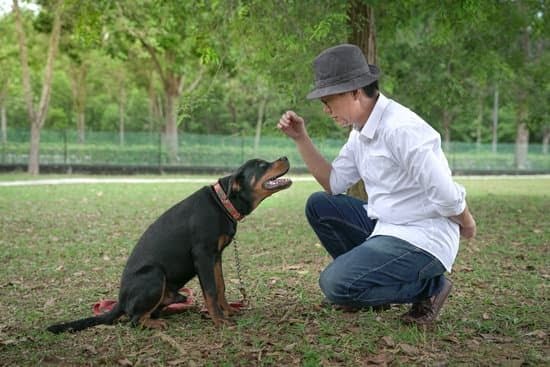Are you wondering how to train your dog to circle behind you? Teaching your furry friend this command can be both practical and fun, and it strengthens the bond between you and your pet.
In this article, we will explore the reasons behind the behavior of dogs circling behind their owners and the importance of training them to do so. You’ll also find a step-by-step guide on how to effectively train your dog to circle behind you, along with tips on troubleshooting and reinforcement.
Understanding why dogs exhibit certain behaviors is crucial in training them effectively. Many dogs naturally circle or position themselves behind their owners as a way of seeking protection or showing affection. Understanding this behavior will help you know how best to address it and train your dog in a way that is positive and nurturing.
Training your dog to circle behind you serves dual purposes; not only does it provide mental stimulation for your pet, but it also strengthens obedience and reinforces trust between both of you. As we dive into the step-by-step guide, make sure to keep in mind that every dog is unique, so patience, consistency, and positive reinforcement are key throughout the training process.
Assessing your dog’s readiness for training is an important first step before jumping into the training process. Look out for signs of comfort and confidence from your dog, as well as any behavioral cues that indicate they are ready to learn. Once you’ve established readiness, follow our comprehensive step-by-step guide to teach your dog the command “circle behind” effectively.
The Importance of Training Your Dog to Circle Behind You
Many dog owners have observed their pets circling behind them, often in a circular motion. This behavior is rooted in a dog’s natural instincts and communication methods. In the wild, dogs often circle around each other as a way of greeting or showing deference to another pack member. When your dog circles behind you, it may be trying to communicate its submission, seek attention, or simply trying to figure out your movements and intentions.
Training your dog to circle behind you is not just about controlling its behavior, but also about building a stronger bond between you and your pet. Teaching your dog this command can help establish your role as the leader while promoting trust and obedience. Additionally, getting your dog to walk in a specific position behind you can be beneficial for situations such as crowded areas or when walking with others.
Assessing Your Dog’s Readiness for Training
Before beginning the training process, it’s important to assess whether your dog is ready for this particular command. Your pet should already have a good understanding of basic commands such as “sit,” “stay,” and “come.” If these foundational commands are not yet established, it may be helpful to work on those before moving on to teaching your dog to circle behind you.
| Importance of Training | Data |
|---|---|
| Communication | Establishes submission and builds trust |
| Situational Benefits | Helps control behavior in crowded areas |
| Bond Strengthening | Promotes trust and obedience between owner and pet |
Assessing Your Dog’s Readiness for Training
Some dogs naturally exhibit the behavior of circling behind their owners, and it’s important to understand why they do this. In many cases, dogs have a natural instinct to stay close to their owners while also keeping an eye on their surroundings.
This behavior can be traced back to their ancestors who needed to be aware of potential threats while remaining close to the pack. By understanding this instinctual behavior, you can better approach training your dog to circle behind you.
The Importance of Training Your Dog to Circle Behind You
Training your dog to circle behind you is not only a fun trick, but it also reinforces obedience and strengthens the bond between you and your furry friend. Additionally, teaching your dog this command can come in handy during walks or hikes when you need them to move away from distractions or passing pedestrians. Whether for practical purposes or simply for enjoyment, mastering this command is beneficial for both you and your dog.
Step-by-Step Guide to Teaching Your Dog to Circle Behind You
Building a Strong Foundation
Before beginning the training process, it’s essential to ensure that your dog has mastered basic commands such as ‘sit’, ‘stay’, and ‘come’. These foundational commands will provide the groundwork for understanding more advanced instructions like circling behind you.
Evaluating Physical Ability
It’s important to take into account your dog’s size and physical capability when considering teaching them how to circle around you. Larger breeds may find it more challenging due to their size, so gradual and patient training is essential.
Reward-Based Approach
When introducing the concept of circling behind you, always use positive reinforcement such as treats and praise. This will help create a positive association with the behavior and encourage your dog’s willingness to learn.
Remember that every dog is unique, so be patient and attentive during this process.
Step-by-Step Guide to Teaching Your Dog to Circle Behind You
Dogs have a natural inclination to circle or move in a circular pattern for various reasons. One common reason is that circling allows dogs to create a comfortable spot to rest, much like when they were wild and would walk around in circles before lying down.
In the context of walking behind their owner, circling can also be a way for dogs to establish and maintain their position in the pack hierarchy. By encouraging your dog to circle behind you on command, you are strengthening your leadership role and reinforcing positive behavior.
The Importance of Training Your Dog to Circle Behind You
Training your dog to walk obediently and confidently behind you has numerous benefits. The ability to have your dog move behind you on command not only establishes you as the pack leader but also creates a sense of structure and safety for your pet. It can be a useful tool when navigating through crowded spaces or crossing roads, as well as during activities like hiking or jogging where maintaining a specific formation is important for safety reasons.
Assessing Your Dog’s Readiness for Training
Before starting the actual training process, it’s crucial to assess whether your dog is physically and mentally prepared for learning this command. Your dog should already have a basic understanding of walking on a loose leash and responding positively to obedience cues. If these fundamental skills are not yet established, consider working on them first before progressing onto more advanced commands such as circling behind you.
| Concept | Importance |
|---|---|
| Circling behavior | Establishes pack hierarchy and reinforces positive behavior. |
| Safety | Creates structure and promotes safety during walks or outdoor activities. |
| Readiness assessment | Determines if foundational skills need further work before advanced training. |
Tools and Equipment Needed for Training
Training your dog to circle behind you requires a few tools and equipment to ensure the process goes smoothly. One of the most important tools you will need is a sturdy leash, preferably a long one to allow for enough slack as your dog moves behind you. A harness or collar that fits comfortably on your dog is also essential. It’s important to choose a leash and collar/harness that your dog is already familiar with and comfortable wearing.
Another key piece of equipment you’ll need is a supply of treats that your dog finds particularly enticing. These treats will serve as positive reinforcement during the training process, rewarding your dog for successfully following the command to circle behind you.
Additionally, having a clicker can be helpful in marking the exact moment when your dog exhibits the desired behavior. Alternatively, if you prefer not to use a clicker, a verbal marker such as “yes” can work just as effectively.
When choosing treats for training, opt for small, soft treats that are easy for your dog to consume quickly. This will keep the training moving at a steady pace and minimize interruptions. Remember that each dog is unique, so it may take some experimentation to find the perfect treat that motivates your furry friend.
Lastly, consider using a training pouch or bag to store the treats conveniently while keeping your hands free during training sessions. By ensuring you have these essential tools and equipment on hand, you’ll set yourself up for success in training your dog to circle behind you.
Common Mistakes to Avoid During Training
When training your dog to circle behind you, it’s important to be aware of common mistakes that can hinder the learning process. By avoiding these pitfalls, you can ensure that your training sessions are productive and successful. Here are some common mistakes to steer clear of:
- Using harsh punishment: It’s crucial to remember that positive reinforcement is key when training your dog. Using aversive methods or punishing your dog for not understanding the command can create anxiety and fear, making it more difficult for them to learn.
- Inconsistency: Inconsistent training can lead to confusion for your dog. Make sure everyone in the household is using the same cues and commands, and that training sessions are held regularly.
- Skipping steps: Training your dog to circle behind you requires a step-by-step approach. Skipping essential steps in the process can lead to confusion and frustration for both you and your pet.
As you work on teaching your dog this behavior, keep these common mistakes in mind so that you can avoid them and set yourself up for success. Remember, patience and positive reinforcement are key ingredients for effective training.
Troubleshooting
If your dog is struggling with the command to circle behind you, it’s important to assess the possible reasons for their difficulty and address them accordingly. Here are some troubleshooting tips to help you overcome any challenges:
1. Assess your dog’s understanding: Take a step back and evaluate whether your dog truly understands the command. If they are consistently having trouble, it may be necessary to go back to basic obedience training and reinforce their understanding of fundamental commands such as “sit,” “stay,” and “come.”
2. Identify distractions: Dogs can easily become distracted, especially when learning a new behavior. Take note of any potential distractions in your training environment, such as other animals, unfamiliar noises, or people. Minimize these distractions as much as possible during training sessions to help your dog focus on the command.
3. Adjust your approach: Every dog is unique and may respond differently to various training methods. If your dog is struggling with the command, consider adjusting your approach. This might involve using higher value treats as motivation, breaking down the steps of the behavior into smaller increments, or seeking assistance from a professional dog trainer.
Remember that patience and positive reinforcement are key during troubleshooting. It’s important not to get frustrated with your dog if they are having difficulty – instead, remain calm and provide encouragement. With dedication and persistence, you can help your dog overcome any obstacles they may face while learning to circle behind you.
Reinforcing the Behavior and Making It a Reliable Command for Your Dog
Now that your dog has learned to circle behind you, it’s important to reinforce this behavior and make it a reliable command. By doing so, you can ensure that your dog will consistently obey this command in various situations.
Consistency Is Key
Consistency is crucial when reinforcing the behavior of circling behind you. Make sure to use the same verbal command and hand signal each time you ask your dog to perform this action. By being consistent, your dog will learn to associate the command with the specific behavior you’re asking for.
Positive Reinforcement
Using positive reinforcement, such as treats, praise, and toys, is essential to solidify the circling behavior as a reliable command for your dog. Whenever your dog successfully circles behind you on command, immediately reward them with their favorite treat or toy and shower them with praise. This positive association will motivate your dog to continue obeying the command.
Practice in Different Environments
To ensure that circling behind you becomes a reliable command for your dog, practice in different environments and scenarios. Start by practicing in familiar settings with minimal distractions, then gradually introduce more challenging environments. By doing so, your dog will learn to perform the command no matter where you are or what is happening around them.
Remember that consistency and patience are key when reinforcing this behavior. With time and practice, circling behind you will become second nature for your dog, making it a reliable and impressive command they can perform at any given moment.
Taking the Training to the Next Level
In conclusion, once you have successfully trained your dog to circle behind you, it is important to take the training to the next level by adding distractions and increasing the distance. This is a crucial step in ensuring that your dog can perform the command reliably in various situations and environments. By gradually introducing distractions such as other people, animals, or noises, you are helping your dog generalize the behavior and respond to the command regardless of external stimuli.
Adding distance to the command also builds your dog’s confidence and strengthens their obedience. Start by practicing in familiar settings and gradually increase the distance between you and your dog. This will not only solidify their understanding of the command but also enhance your bond as a team. Remember to use positive reinforcement and patience during this process, rewarding your dog for successfully completing the command even in challenging situations.
As you progress with the training, continue to assess your dog’s readiness and adjust the difficulty of the exercises accordingly. It is crucial to set realistic expectations and celebrate each step of progress towards mastering this advanced skill. With dedication and consistency, you will be able to enjoy a harmonious relationship with your well-trained canine companion who confidently circles behind you on command no matter what distractions or distance may be present.
Frequently Asked Questions
How Do You Train a Dog to Circle Around You?
Train a dog to circle around you by using positive reinforcement techniques. Start by teaching your dog the “heel” command and then gradually introduce the concept of circling around you while maintaining the heel position.
Use treats or toys to guide and reward your dog as they successfully circle around you. Be patient and consistent in your training, as it may take some time for your dog to understand and execute this command reliably.
What Is the Circle Training for Dogs?
Circle training for dogs is a valuable skill that involves teaching a dog to move in a circular path around their owner while maintaining a certain distance and position. This type of training can improve a dog’s focus, agility, and overall obedience.
It also strengthens the bond between the owner and the dog, as it requires clear communication and trust between both parties.
How Do You Teach a Dog to Go Behind You?
To teach a dog to go behind you, start with basic obedience training to ensure that your dog already knows how to follow commands such as “sit,” “stay,” and “come.” Once these foundational skills are in place, use a combination of verbal cues, hand signals, and rewards to encourage your dog to move behind you on command.
Practice this skill regularly in different environments to help your dog generalize the behavior and respond consistently.

Welcome to the blog! I am a professional dog trainer and have been working with dogs for many years. In this blog, I will be discussing various topics related to dog training, including tips, tricks, and advice. I hope you find this information helpful and informative. Thanks for reading!





